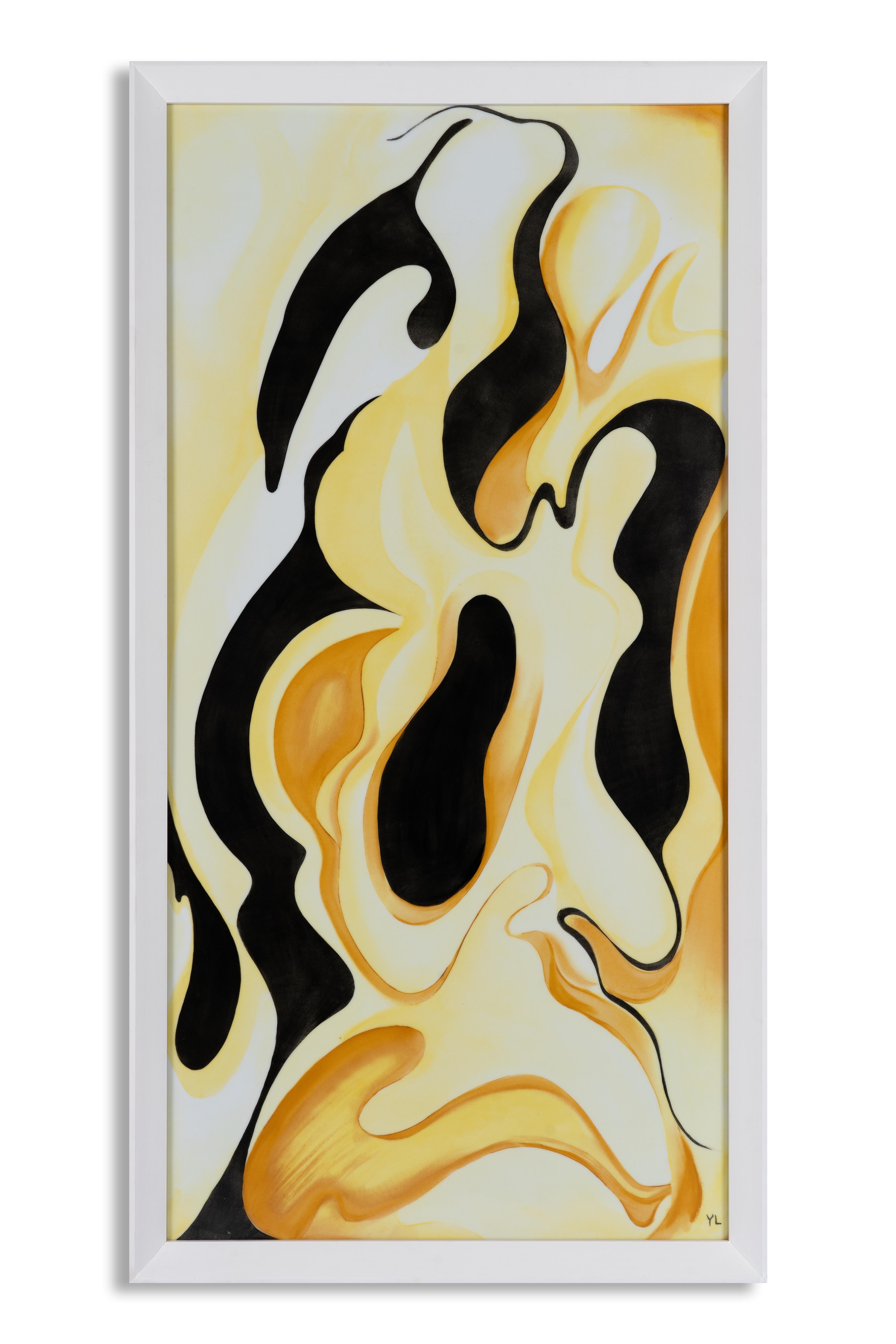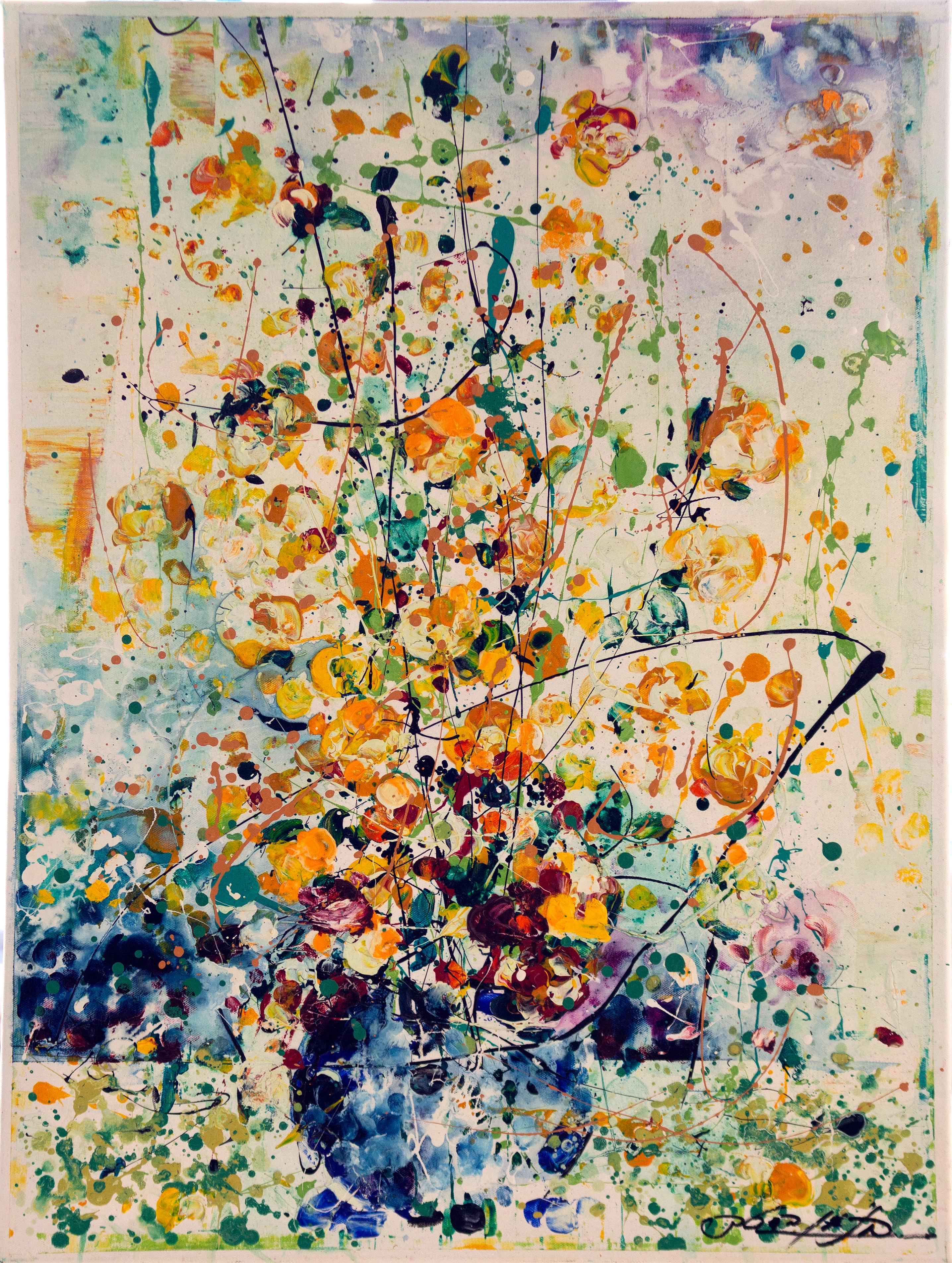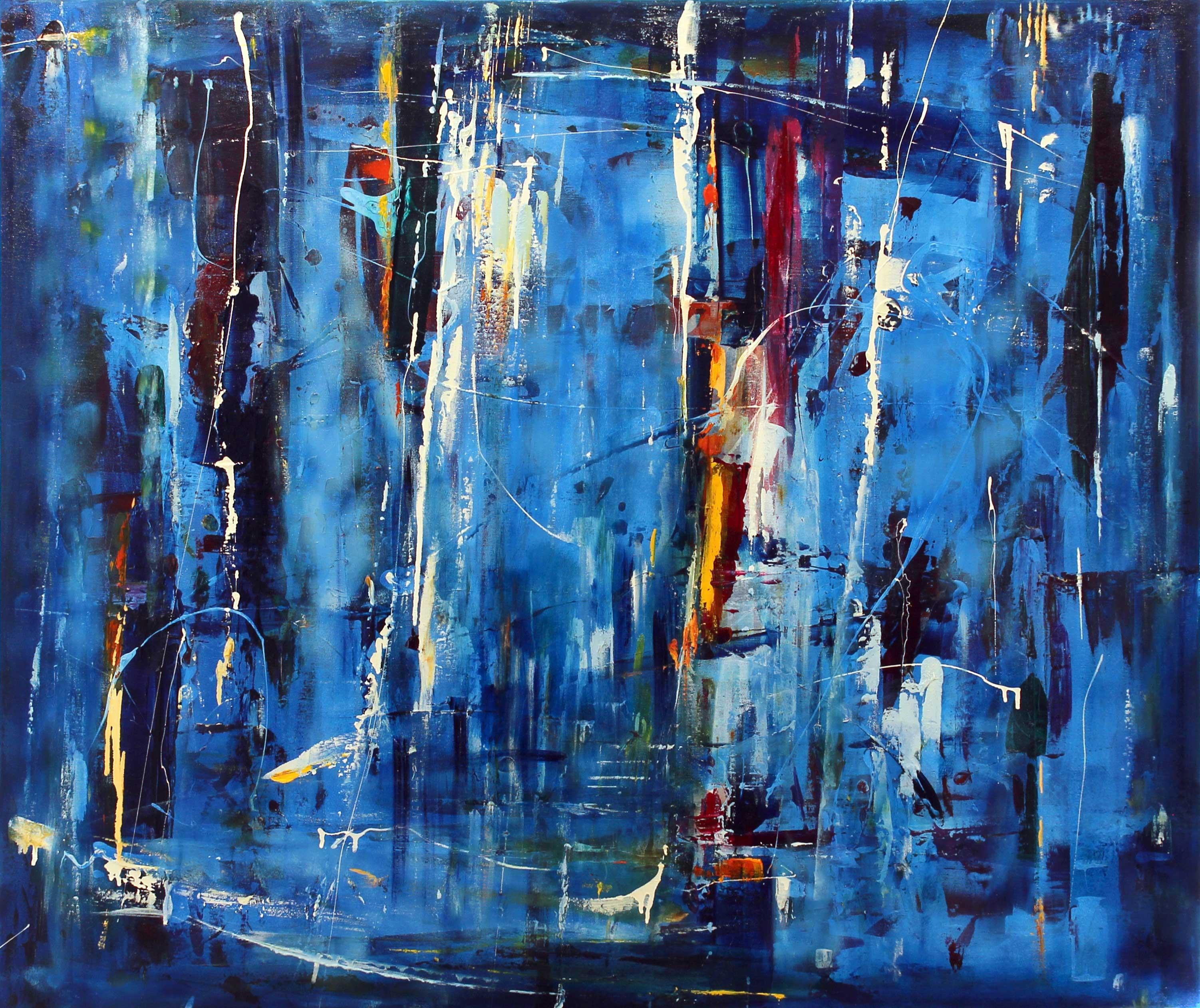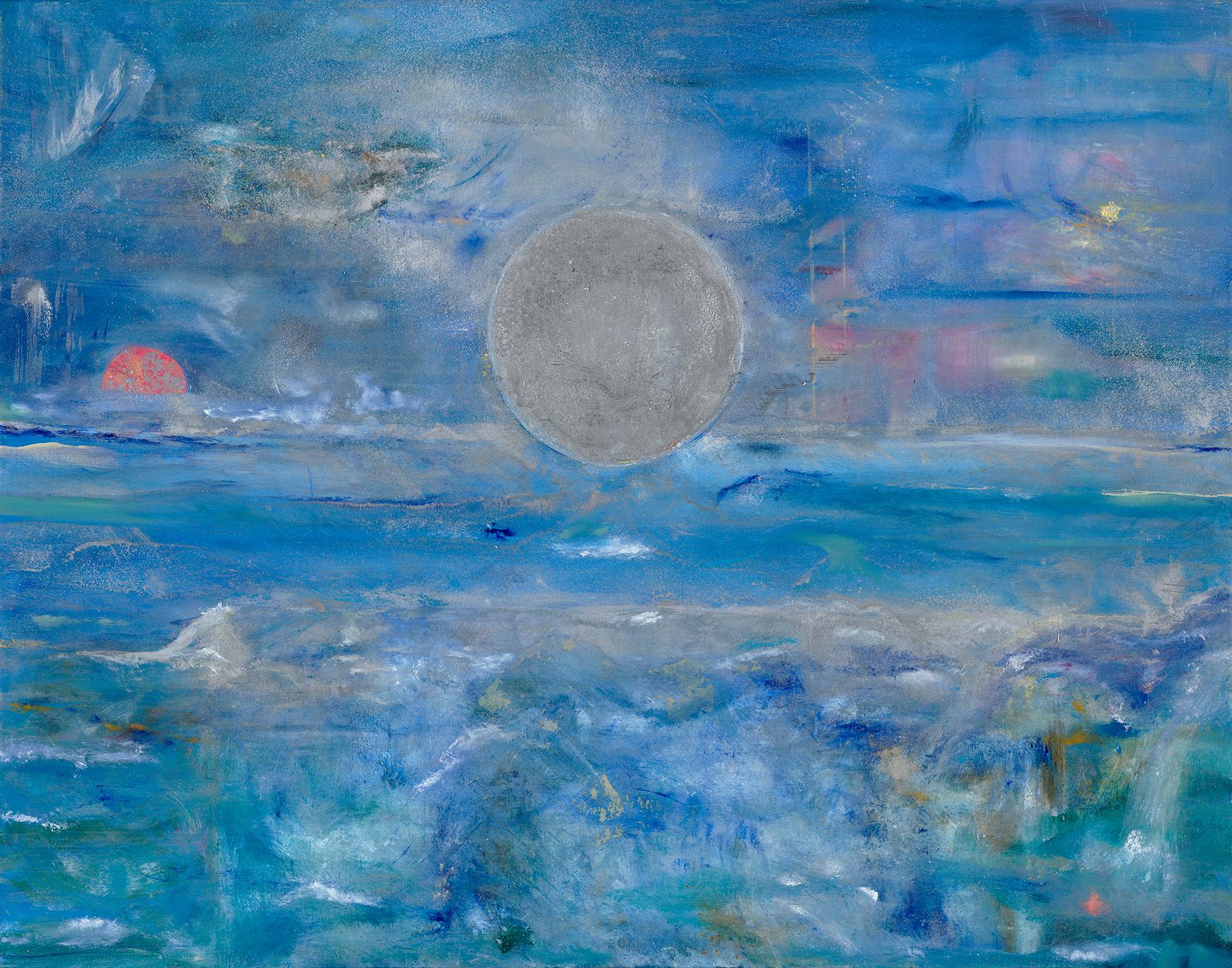Items Similar to Abstract Landscape Red Green - Scottish Abstract Expressionist art oil painting
Want more images or videos?
Request additional images or videos from the seller
1 of 16
William GearAbstract Landscape Red Green - Scottish Abstract Expressionist art oil painting1949
1949
About the Item
This stunning Scottish Abstract Expressionist oil painting is by noted Scottish artist William Gear. Painted in 1949 it is an early and significant painting which dates to the early part of his career. Entitled Abstract Landscape with Red and Green it was painted during Gear's time in Paris and involvement with COBRA. Mostly red and green shapes are incased in black on a vivid yellow background. A really pleasing composition to the eye and perfectly housed in an ebonised frame, it is an excellent example of Gear's work.
Signed and Dated '49 lower right. Inscribed, titled and dated verso.
Provenance: Cornish collection.
Condition. Acrylic on canvas 25 inches by 20 inches and in good condition.
Frame. Housed in an ebonised frame, 30 inches by 25 inches and in good condition.
Few British painters have played an active role in the modern abstract movement of post-war Europe. William Gear was the most passionate and committed exception. He continued the tradition of the Edinburgh-Paris axis established by J.D. Fergusson, Samuel Peploe and others, spending vital years between 1947 and 1950 living and working in Paris. Significantly, in recent years, he received the greatest acclaim in France, Germany and the Netherlands.
He was born in 1915 in Methil, Fife, into a mining family; the particular landscape of "pitheads, the sea, rocks, castles, trees, storms and poverty" marked his earliest identity with a place and probably remained the most influential to his art. Years later he recalled as a schoolboy visiting the local art gallery in Kirkcaldy and seeing 12 colourful still-lifes by Peploe. Art-history lessons during student years at Edinburgh College of Art, in particular Byzantine classes under David Talbot Rice, also influenced his concern for structure. This had as much to do with the formal language of painting as sheer delight in the medium itself. Gear never missed an opportunity to show people the merits of a well-constructed painting.
On a travelling scholarship in 1937, he chose to study with Fernand Leger, described by Gear as "a keystone for me, seldom abstract, rather a degree of abstraction". The Second World War interrupted these formative years and, by 1940, Gear had joined the Royal Corps of Signals. Dispatched to the Middle East, he still had the discipline to paint - mostly works on paper of damaged landscapes - with exhibitions in Jerusalem, Tel Aviv, Cairo as well as Siena and Florence.
His naturally robust and tenacious temperament was profoundly affected by visiting Bergen-Belsen, and this certainly influenced the later experiments with the black armature. As the British officer in Celle, working for the Monuments, Fine Arts and Archives Section of the Control Commission, he focused on securing the safety of the Berlin Art Collection in Schloss Celle, and organised an important series of modern art exhibitions, including the rejected work of Karl Otto Gotz. Only a few weeks before his death, this service to "democratic art and artistic freedom" was recognised in Hanover by a unique Leporello Award, appropriately instigated by fellow artists and presented by the Lower Saxony government.
Demobbed in 1947, Gear headed for Paris, where he established a one-room studio at 13 Quai des Grands Augustins. This exciting period saw him gravitating towards what he called "the freer, dramatic approach of abstraction lyrique" rather then "the dogmatic hard-edged school of Mondrian and De Stijl". Within a year there were exhibitions at two of the pioneering salons and a first one-man show at the Galerie Arc en Ciel.
At the same time inclusion in Cobra shows in Amsterdam and Copenhagen in 1949, alongside Constant, Corneille and Appel, underpinned his affiliation to a reinvigorated form of abstract expressionism. He worked at the time in the fluid medium of opaque water-colour, usually on card with pockets of intense colour on a white or neutral ground. While some pieces were purely abstract, others carried their own suggestion of landscape, or even a form of Celtic figuration.
The same year saw an exhibition at the Betty Parsons Gallery in New York, alongside Jackson Pollock. The impact of American abstract expressionism however remained a sore subject, which in conversation was usually dismissed with a curt reminder of what he and others were already painting in Europe.
The decision to return to England in 1950 was both personal and practical. Recently married to Charlotte Chertok, and with a baby, he had already secured in 1948 the first of a series of London exhibitions with the Gimpel Fils Gallery. The atmosphere surrounding the Festival of Britain also appeared to offer fresh opportunities.
Notoriously, Gear was awarded one of the Festival of Britain Purchase Prizes for Autumn Landscape, a large oil on canvas which took six difficult months to complete. The event produced written questions and answers in the House of Commons and a tirade of abuse from the national press, not to mention a topic for debate on the radio programme Any Questions. While the episode made him a household name, the longer-term effects were, arguably, more detrimental.
He chose not to live in London or join fellow abstract artists in St Ives, preferring the independence of a village in Kent between 1953 and 1958. This period saw the continued development of large landscape structures, as well as "side-roads" into sculptural subjects and minimalist colour paintings, which openly acknowledged the influence of Nicolas de Stael. These works have still to be properly exhibited. Mau-Mau (1953), for example, painted for the Contemporary Art Society but at the last minute withdrawn from display at the Tate Gallery, has its first London showing in the current golden jubilee exhibition at the Redfern Gallery.
Gear was out of critical favour for most of the 1960s and 1970s. He exhibited more irregularly, despite returning to the use of dark structures broken by selected movements and light-inflected primary colours. While contemporaries questioned his move to Eastbourne as Curator of the Towner Art Gallery (1958-64), Gear's response was to take on the Purchase Committee. He changed the local authority's collection policy from Victorian and local views to securing the foundation of a major collection of post-war British art.
His move to Birmingham came with the appointment as Head of the Faculty of Fine Art, Birmingham College of Art, in 1964, a post held until retirement in 1975, by which time he had become increasingly un- interested in the growing bureaucracy surrounding art education. His support and encouragement to artists living in Birmingham however continued with the purchases made for Birmingham Museums and Art Gallery on behalf of the Friends organisation (1987-94) as well as for his own personal collection. Most recently he instigated the idea of a gallery of modern art in Birmingham.
Fortunately, the last 15 years have also gone some way to reverse the years of neglect. Gear and Stephen Gilbert (also Scottish) were the only British artists included in the major Cobra 1948-51 exhibition at the Musee d'Art Moderne, Paris, in 1982. The Cobra enthusiast Karel van Stuijvenberg has been a prominent patron and, in 1995, Gear took delight in attending the opening of the Cobra Museum of Modern Art in Amstelveen, near Amsterdam. He was equally proud of his long overdue election to the Royal Academy in 1995, and in the last years relished working with the fluidity and strong colours of oil stick. Tessa Sidey.
Exhibited and held by worldwide galleries including The Tate.
- Creator:William Gear (1915-1997, Scottish)
- Creation Year:1949
- Dimensions:Height: 25 in (63.5 cm)Width: 30 in (76.2 cm)Depth: 2 in (5.08 cm)
- Medium:
- Movement & Style:
- Period:
- Condition:
- Gallery Location:London, GB
- Reference Number:1stDibs: LU853113431742
About the Seller
5.0
Platinum Seller
These expertly vetted sellers are 1stDibs' most experienced sellers and are rated highest by our customers.
1stDibs seller since 2018
398 sales on 1stDibs
Typical response time: <1 hour
- ShippingRetrieving quote...Ships From: London, United Kingdom
- Return PolicyA return for this item may be initiated within 14 days of delivery.
More From This SellerView All
- New Vision - Canadian Abstract Expressionist art 60s oil painting landscape pinkBy William John Bertram NewcombeLocated in London, GBAn original large abstract oil on canvas by British Canadian artist William John Bertram Newcombe. This stunning abstract expressionist oil painting is a bold, adventurous and conf...Category
20th Century Abstract Expressionist Abstract Paintings
MaterialsMixed Media, Oil
- Waterfront - British 1960's art Abstract Expressionist exhibited oil paintingBy Helen HaleLocated in London, GBThis stunning abstract expressionist oil on canvas is by artist Helen M Hale. Painted in the 1960's this abstract landscape has strong brushwork and blocks of colour. Labelled verso...Category
1960s Abstract Expressionist Landscape Paintings
MaterialsOil
- Early Spring - Scottish Abstract Expressionist art landscape oil paintingBy William GearLocated in London, GBAn original oil on canvas by noted Scottish artist William Gear which dates to 1981. Entitled early Spring it is a vibrant and fresh art work with lovely colouring. Signed, dated and titled verso. Provenance. William Gear estate. Royal Birmingham Society of Artists 1981. Condition. Oil on canvas, 48 inches by 32 inches. Excellent condition. William Gear (1915-1997). Few British painters have played an active role in the modern abstract movement of post-war Europe. William Gear was the most passionate and committed exception. He continued the tradition of the Edinburgh-Paris axis established by J.D. Fergusson, Samuel Peploe and others, spending vital years between 1947 and 1950 living and working in Paris. Significantly, in recent years, he received the greatest acclaim in France, Germany and the Netherlands. He was born in 1915 in Methil, Fife, into a mining family; the particular landscape of "pitheads, the sea, rocks, castles, trees, storms and poverty" marked his earliest identity with a place and probably remained the most influential to his art. Years later he recalled as a schoolboy visiting the local art gallery in Kirkcaldy and seeing 12 colourful still-lifes by Peploe. Art-history lessons during student years at Edinburgh College of Art, in particular Byzantine classes under David Talbot Rice, also influenced his concern for structure. This had as much to do with the formal language of painting as sheer delight in the medium itself. Gear never missed an opportunity to show people the merits of a well-constructed painting. On a travelling scholarship in 1937, he chose to study with Fernand Leger, described by Gear as "a keystone for me, seldom abstract, rather a degree of abstraction". The Second World War interrupted these formative years and, by 1940, Gear had joined the Royal Corps of Signals. Dispatched to the Middle East, he still had the discipline to paint - mostly works on paper of damaged landscapes - with exhibitions in Jerusalem, Tel Aviv, Cairo as well as Siena and Florence. His naturally robust and tenacious temperament was profoundly affected by visiting Bergen-Belsen, and this certainly influenced the later experiments with the black armature. As the British officer in Celle, working for the Monuments, Fine Arts and Archives Section of the Control Commission, he focused on securing the safety of the Berlin Art Collection in Schloss Celle, and organised an important series of modern art exhibitions, including the rejected work of Karl Otto Gotz...Category
20th Century Abstract Expressionist Abstract Paintings
MaterialsOil
- Abstract Expressionist - Original 60's oil/spray paint on paper S. African artBy Denis BowenLocated in London, GBAn original oil and spray paint on paper by Denis Bowen who played an important role in the Post War British art movement. This simple yet stunning work dates to 1962. Signed and dated verso. Provenance. Northern collection. Condition. Oil and spray paint on paper. Image size 26 inches by 18 inches and in fine gallery condition. Housed in a simple black gallery frame in excellent condition, 28 inches by 20 inches. Denis Bowen (1921-2006) was a South African artist, gallery director and promoter of abstract and avant-garde art in Britain. He was founder of the New Vision Group and the New Vision Centre Gallery, both of which played an important role in the post-World War II British art scene. Denis Bowen was born on 5 April 1921 in Kimberley, South Africa. His father was Welsh and his mother English. After being orphaned at a young age, Bowen moved to England where he was raised by his aunt in Huddersfield. He enrolled at the Huddersfield School of Art in 1936. After serving in the Navy in World War II, Bowen resumed his art studies at the Royal College of Art in London in 1946. Between 1940 and 1986 Bowen taught art at numerous institutions including: the Kingston Institute of Art, Hammersmith School of Art, Birmingham School of Art, the Central School of Art and Design, the Royal College of Art and the University of British Columbia in Vancouver. In 1951 Bowen founded the New Vision Group, which initially emerged from meetings and displays that he organised with his students in 1951. In 1955, Bowen worked alongside Frank Avray Wilson and Halima Nalecz...Category
1960s Abstract Expressionist Abstract Paintings
MaterialsPaper, Oil, Spray Paint
- Midsummer - Scottish Abstract Expressionist exhibited art oil paintingBy Iain RobertsonLocated in London, GBThis striking exhibited large abstract oil painting is by noted Scottish artist Iain Robertson. Painted in 1998 and exhibited in the same year in London, it was completed just before he moved to Cornwall. Entitled Midsummer verso it is a riot of summery colours and heavy impasto and late twentieth century abstract expressionism. A really uplifting piece of art. Signed and inscribed with title and dated 1998 verso. Provenance. Solo show, 'Art First', London, 1998. Condition. Oil on Canvas. Size 60 x 24 inches Frame. Housed in surround frame, 62 inches by 26 inches and in good condition. Iain Robertson (b. 1955) was born in Cyprus but grew up in Edinburgh before studying art, 1978-1982. In 1993 he worked as Artist In Residence at Grizedale Sculpture Park before relocating to Cornwall where he now lives and works. He has retained studio 7 at Porthmeor Studios in St Ives, since 2007. Previously Robertson worked in Montgomery Street Studio, Edinburgh, 1991-1999. He has exhibited widely with numerous solo shows in the UK and Europe. His work is held in public and private collections in Germany, Denmark, Norway, Scotland, England, USA and Hong Kong. His work was included in the ‘Art Now Cornwall’ exhibition at TATE St Ives Spring 2007 and at the City Art Centre, Edinburgh, 2007. The recipient of a number of awards including Scottish Arts Council, British Council and Arts Council, Robertson was the first Scottish recipient of the Pollock Krasner Foundation, New York, in 1988. Notable exhibitions include, Contemporary Abstract Printmaking, Artists- Rachel Clark, Ian Davenport, Christopher Le Brun, John McLean, Mali Morris...Category
1990s Abstract Expressionist Abstract Paintings
MaterialsOil
- New Vision 2 - British Canadian art 60's Abstract Expressionist oil paintingBy William John Bertram NewcombeLocated in London, GBAn original large abstract oil on canvas by British Canadian artist William John Bertram Newcombe. This stunning abstract expressionist oil is a bold, adventurous and confident abstr...Category
20th Century Abstract Expressionist Abstract Paintings
MaterialsMixed Media, Oil
You May Also Like
- DaydreamsLocated in Southampton, NYPart of a new collection of painted porcelain panels by Chinese artist Yuan Lin, “Daydreams” is a luminous meditation on the sun's rays. In this painting, Lin...Category
2010s Abstract Expressionist Abstract Paintings
MaterialsCeramic, Glaze, Oil
- Mindy Weisel, Not Everything is Black and White , 2017 oil on canvas 91 x 91By Mindy WeiselLocated in Jerusalem, ILMindy Weisel Not Everything is Black and White , 2017 oil on canvas 91 x 91 cm 36 x 36 in Exhibited Mindy Weisel "Meditations on Love", Rosenbach Conte...Category
2010s Abstract Expressionist Abstract Paintings
MaterialsCanvas, Oil
- Binyamin Basteker, The sounds of flowers (Jerusalem flower series) oil on canvasLocated in Jerusalem, ILBinyamin Basteker The sounds of flowers , 2020 oil on canvas 80 x 60 cm 31 x 24 in Exhibited: "Jerusalem Flowers", 2020 Rosenbach Contemporary, Jerusalem Binyamin Basteker was bo...Category
2010s Abstract Expressionist Abstract Paintings
MaterialsOil
- Binyamin Basteker First rain in Jerusalem , 2018 oil on canvas 100 x 120 cmLocated in Jerusalem, ILBinyamin Basteker First rain in Jerusalem , 2018 oil on canvas 100 x 120 cm 39 x 47 in As a student of the masterful colorists of India and the Israeli abstract masters of the 1970s, Basteker has developed a unique style of painting. He loves color, he loves abstract and he loves the holy city...Category
2010s Abstract Expressionist Abstract Paintings
MaterialsOil
- Jacob's Ladder, 2021 oil on canvas oil on canvas 110 x 140 cm (43 x 55 in)By Raquel SanchezLocated in Jerusalem, ILRaquel Sanchez Jacob's Ladder , 2021 oil on canvas 110 x 140 cm (43 x 55 in) Exhibited: Jerusalem Biennale 2021 Influenced by the Impressionist and Modern masters, Raquel's perso...Category
2010s Abstract Expressionist Abstract Paintings
MaterialsOil
- Binyamin Basteker, Abstract composition , 1990 oil on canvas 87 x 115 cmLocated in Jerusalem, ILBinyamin Basteker Abstract composition , 1990 oil on canvas 87 x 115 cm 34 x 45 in Binyamin Basteker was born in Mumbai in 1953. Growing up in a family of artists, his unique tal...Category
1980s Abstract Expressionist Abstract Paintings
MaterialsOil





